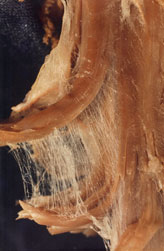"Fascia is the organ of posture. Nobody ever says this; all the talk is about muscles. Yet this is a very important concept, and because this is so important, we as Practitioners must understand both the anatomy and physiology, but especially the anatomy of fascia. The body is a web of fascia. A spiderweb is in a plane. This web is in a sphere. We can trace the lines of that web to get an understanding of how what we see in a body works." -Ida P. Rolf, Ph.D.
Fascia 
When the form of you began inside your mother, the first tissue to appear as you grew was fascia. Fascial tissue then created, and grew along with, every other part of your body. So the fascial structure runs through your body in a single unbroken strand, with every part aware of, and compensating for, the "whole" of you. It is a very tough and strong, fibrous tissue which surrounds every organ, muscle, bone, nerve and blood vessel, binding these structures together much like plastic wrap would hold the contents of a sandwich together. Fascia maintains a consistent form for the structures in the body and allows mobility for the entire structure in the field of gravity. The movements of your muscles are determined by the organization, or lack thereof, in your fascia.
Healthy fascia is elastic and pliable, whereas unhealthy fascia is glue-like, hardened, dehydrated, and shortened caused by a number of factors – past injuries, physical and/or emotional trauma, overuse and misuse of body structures, accumulation of stress from daily life activities, habitual movement patterns, and the force of gravity. Fascial tissue has a “plastic” quality allowing it to adapt and conform to your posture or habitual holding patterns. Sitting at the office, or on the couch, slouching over the computer, and slouched standing posture are all factors that will contribute to hardened short fascia. When fascia shortens, it will adopt these less-than-optimal patterns and pull the body out of alignment, thereby causing “dis-ease”, malaise, chronic pain, tension, and rigidity, etc.
So the goal of Structural Integration is to organize the fascia in your body into its optimal pattern. During sessions, I will release and organize the tight places in your fascia. Then I will show you how to control and think about your movements, so that you can create good habits and patterns that support mobility. By creating the "perfect movement" in your body, and then making that "perfect movement" a habit, you can enjoy a lifetime of activity, free from chronic pain.
